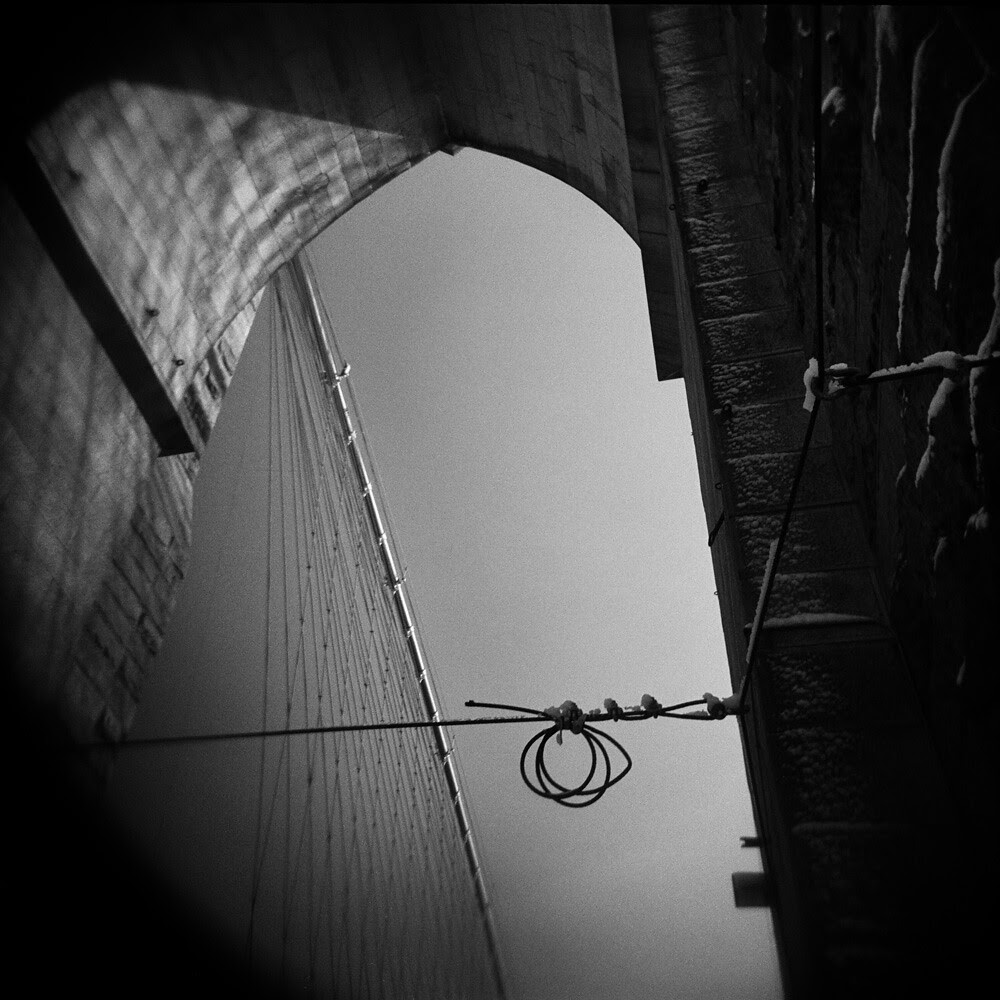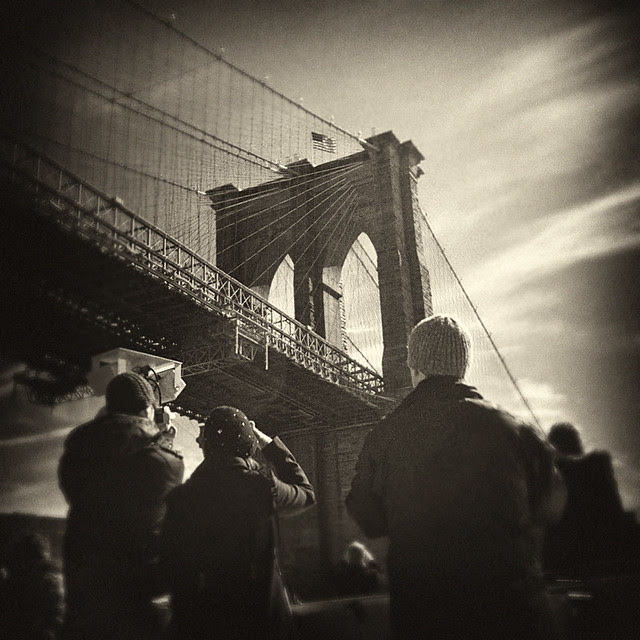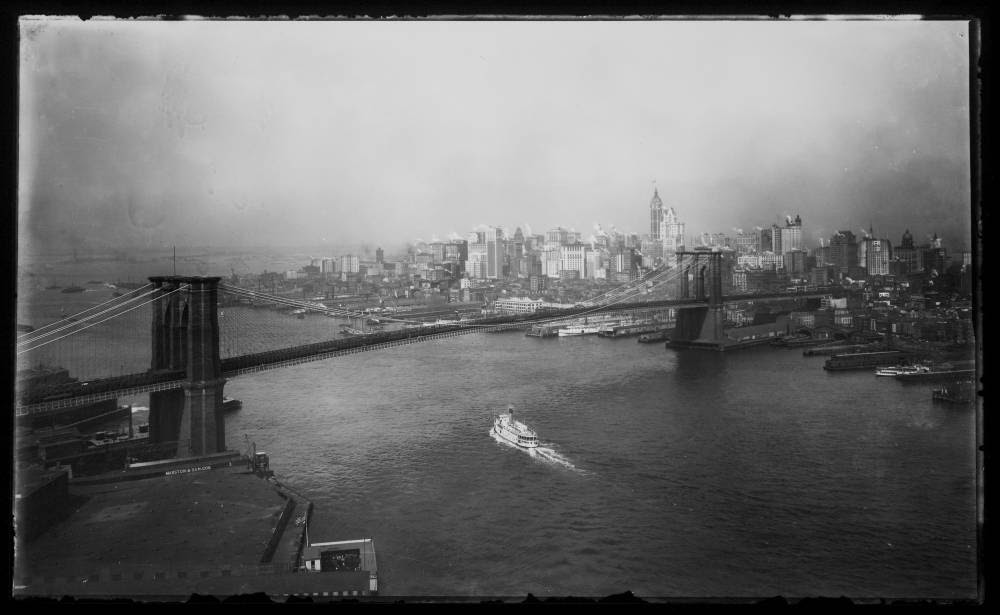.

Brooklyn Bridge #1 (New York City, New York): photo by Jim Rohan, 15 February 2014
If ever .......the end of the world ..............should arrive, and chaos .......sweep off ............. the planet's last ridge, with the only .......lonely ..............thing to survive towering over debris .......this bridge, ..............then, as out of a needle-thin bone .......museums ..............rebuild dinosaurs, so future's geologist .......from this bridge alone ..............will remodel these days .......of ours. Vladimir Mayakovsky: from The Brooklyn Bridge, 1925, in Poems, translated by Dorian Rottenberg, 1972

Brooklyn Bridge, Water and Dock Streets, looking southwest, Brooklyn: photo by Berenice Abbott, 22 May 1936 (New York Public Library)

Bridges from Brooklyn: photo by Irving Underhill, 1913 (Library of Congress)

Painters on the Brooklyn Bridge Suspender Cables: photo by Eugene de Selignac, 7 October 1914 (New York City Municipal Archives / Museum of Photographic Arts Collections)

Under the Brooklyn Bridge, New York City. ("Is it just the normal tourists taking pics, or was there a special event that day?" "A special event indeed! They are waiting for my new world record dive of 277 ft from atop the center bridge tower which would have shattered the existing world high dive record by some 105 ft! Little do they know I am actually behind them with a Holga."): photo by Jim Rohan, 4 March 2011

Talman Street, between Jay and Bridge Streets, Brooklyn: photo by Berenice Abbott, 22 May 1936 (New York Public Library)

View of Brooklyn Bridge: photo by George P. Hall and Son, c. 1905 (George Eastman House)

Mayakovsky, Museum: photo by alex_henri, 24 April 2007

Brooklyn Bridge: photo by George P. Hall and Son, c. 1905 (George Eastman House)



9 comments:
“future’s geologist” remodeling scheme would create an incomplete, misleading picture, but that’s the academic study of history for you and it’s kind of unimportant. Because it has been so cold for so long here, I can’t tell you how warming it is to wake up to something like this. Magazine, museum and gallery wall arrangements of Brooklyn Bridge photographs unexpectedly descended into disappointing cliché following that great Whitney Museum (as I recall) Brooklyn Bridge exhibition that happened around my senior year in college, but the small show you’ve mounted here, along with the Mayakovsky wall legend puts all that to right. Heading up the display with Jim Rohan’s remarkable photograph (taken only two days ago – that’s amazing to me) is the perfect choice. Thank you. I would like to think that someday we will be warm again and that snow won’t seem ponderous and threatening any more. Curtis
Curtis,
Jim Rohan's spooky spiderweb view of the bridge cables -- the seventh photo here -- was posted on the 7th of this month. (Shooting dates and posting dates aren't always synchronous, obviously.) This one was posted eight days later.
Fresh matters.
The Jim Rohan Cities Of Tomorrow photograph below the one you directed me to really gets to me. New York is so very familiar to me in all weather and at all times of day and night, so it's remarkable to be able to see it in new ways. Fresh does matter. I often think that I've been left out too long and started to spoil. Curtis
I always feel like such a hick in NYC--I walk across the Brooklyn Bridge every day, but I never feel as if I am really there. It's as if I've entered some other world, one where I am an alien. Of course, it's silly to think that way since NYC is full of aliens . . .
I love this explanation . . . But who is Holga?
"They are waiting for my new world record dive of 277 ft from atop the center bridge tower which would have shattered the existing world high dive record by some 105 ft! Little do they know I am actually behind them with a Holga."
Magnificent photos, splendid post. Mayakovsky's poem has always enchanted me -- and I was never satisfied with available translations so, with the help of a couple of Russian-speaking friends, I translated it. My version is in my "New and Selected Poems." -- David Lehman
Many thanks, all.
The decision to clip this particularly lucid bit out of an extremely (characteristically) long-winded Mayakovsky work -- well, somewhere in heaven there must dwell a Big Proletarian Editor.
The illusion of a human future revolutionized by the benign advance of technology of course captivated many a "progressive" artist of the early decades of the last century.
Mayakovsky's importance as a cultural figure permitted him unusual travel liberties during the early Soviet era; he made appearances in Latvia, Britain, Germany, the United States, Mexico and Cuba, and published My Discovery of America in 1925.
But how much did he really see or understand from his touristical inspection of harbours, bridges, railroads, big cities?
The social context of these Bridge scenes was documented for the Federal Arts Project by a great urban sociologist of photography, Berenice Abbott, in the Changing New York series, which she supervised.
Two of Abbott's photos are shown here, to represent the contrast between life above and beneath the Bridge.
And Jim Rohan, a contemporary witness, take us beneath the Bridge in the hard, menacing winter light of last week -- the whole massive structure held together by a few bits of slapdash cable knotting, as it appears.
Nin's comment struck a sympathetic nerve. Give her credit -- I'm afraid to hobble across the street in front of my own house. But then the Brooklyn Bridge is probably a whole lot safer than the freeway feeder. And of course everybody thinks their local aliens are the weirdest of all. No wonder all those crazed commuters gunning it up the hill from Tech Town are so intent on mowing down innocent pedestrians (aliens by any other name).
And Nin on Jim Rohan's lower shot -- so happy somebody besides me caught the humour in that caption, so typical of this photographer who is a poet in every way except one (he's missing the pretentiousness).
"I love this explanation . . . But who is Holga?
"They are waiting for my new world record dive of 277 ft from atop the center bridge tower which would have shattered the existing world high dive record by some 105 ft! Little do they know I am actually behind them with a Holga."
Jim might say something like, "a Holga is one of my many human-shaped props..." or "a Holga is a miniature Swiss Army knife with a plastic meniscus lens attachment...", or... "here's a bit of basic info about a Holga..."
Of course, it's the cheap, plastic, toylike physical appearance and ragged and unpredictable performance of the Holga which is contributing to the surprising allegiance it has gained among photographers dissatisfied with digital "perfection".
And on the subject of Mayakovsky and that imaginal Big Proletarian Editor -- it should never be forgot that staying alive and being outspoken, in this period of Russian history, had to be a continual tightrope act.
Mayakovsky managed five more years of it, after writing this poem.
But even in his ascendancy, the wheels of Terror were always grinding shadowily on.
Here is a bit of Trotsky's extremely equivocal encomium, delivered the year before Mayakovksy's American tour:
"Mayakovsky is closer to the dynamic quality of the Revolution and to its stern courage than to the mass character of its heroism, deeds and experiences. Just as the ancient Greek was an anthropomorphist and naively thought of the forces of nature as resembling himself, so our poet is a Mayako-morphist and fills the squares, the streets and fields of the Revolution with his own personality. True, extremes meet. The universalization of one’s ego breaks down, to some extent, the limits of one’s individuality, and brings one nearer to the collectivity – from the reverse end. But this is true only to a certain degree. The individualistic and Bohemian arrogance – in contrast, not to humility, which no one wants, but to a necessary sense of the measure of things – runs through everything written by Mayakovsky. He has frequently a very high degree of pathos in his works, but there is not always strength behind it. The poet is too much in evidence. He allows too little independence to events and facts, so that it is not the Revolution that is struggling with obstacles, but it is Mayakovsky who does athletic stunts in the arena of words. Sometimes he performs miracles indeed, but every now and then he makes an heroic effort and lifts a hollow weight.
"At every step Mayakovsky speaks about himself, now in the first person, and now in the third, now individually, and now dissolving himself in mankind. When he wants to elevate man, he makes him be Mayakovsky. He assumes a familiarity to the greatest events of history. This is the most intolerable, as well as the most dangerous thing in his works. One can’t speak about Stilts or buskins in his case; such props are too poor. Mayakovsky has one foot on Mont Blanc and the other on Elbrus. His voice drowns thunder; can one wonder that he treats history familiarly, and is on intimate terms with the Revolution? But this is most dangerous, for given such gigantic standards, everywhere and in everything, such thunderous shouts (the poet’s favorite word) against the horizon of Elbrus and Mont Blanc – the proportions of our worldly affairs vanish, and it is impossible to establish the difference between a little thing and a big. That is why Mayakovsky speaks of the most intimate thing, such as love, as if he were speaking about the migration of nations. For the same reason he cannot find different words for the Revolution. He is always shooting at the edge, and, as every artilleryman knows, such gunning gives a minimum of hits and tells most heavily on the guns."
--Leon Trotsky: from Literature and Revolution (1924): Chapter 4: Futurism
Tom:
Wow, what terrific images.
The one of the men on the cable-rigging is just other-worldly.
Imagine such a thing happening today. We're probably on the verge of closing the Golden Gate bridge to all non-vehicular traffic, in the name of "safety."
The poems and impressions people wrote about the Brooklyn Bridge are a reminder of the awe people once felt about the progress of civilization. Today we're too "sophisticated" to get much excited about that.
Thanks, Curtis.
Yes, that photo scares me just to look... perhaps it's the sole good thing in not being able to climb stairs any more, one can at last admit to always having been mortally terrified of heights.
Crossing the high bridges over the filthy Chicago River, with only the gridwork between one's feet and the Terrible Brown Gulf, always had me secretly petrified as a kid. The trick seemed to be, don't look down.
This phobia may have been inherited. My wee grandmother, from the cragless County Westmeath, when we were visiting the Grand Canyon in 1950, retreated into the shadow of the De Soto, and refused to be lured within 20 feet of the brink.
And as to the signs of progress marked by our current advanced bridge construction technology -- after all those years of retrofits -- I give you -- let's hear it for -- the Bay Bridge... LEAKS!!
Post a Comment